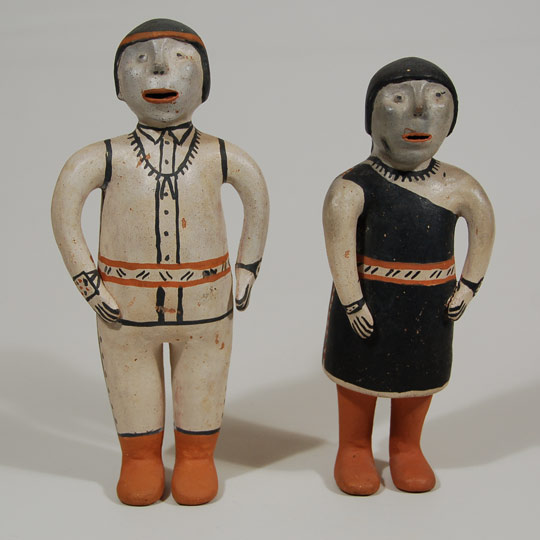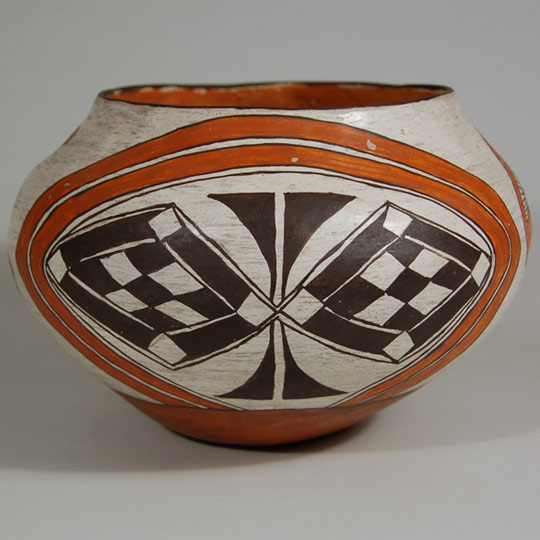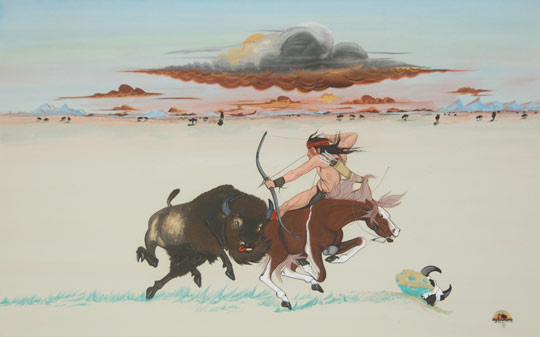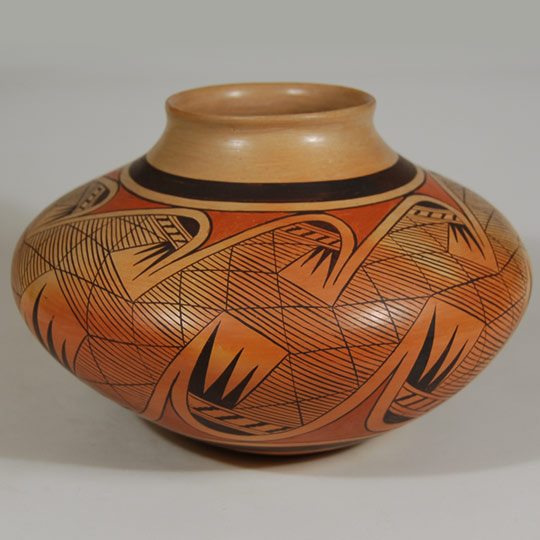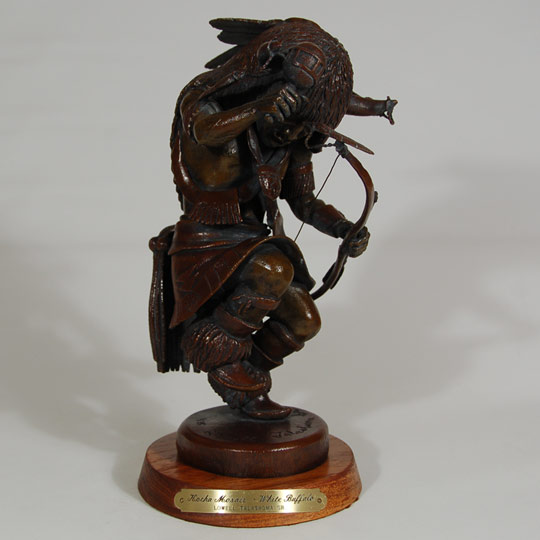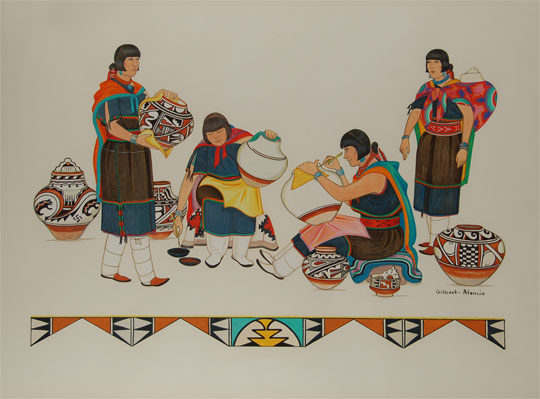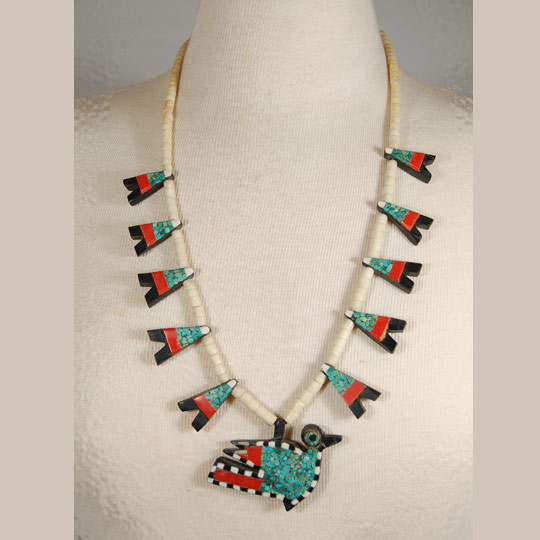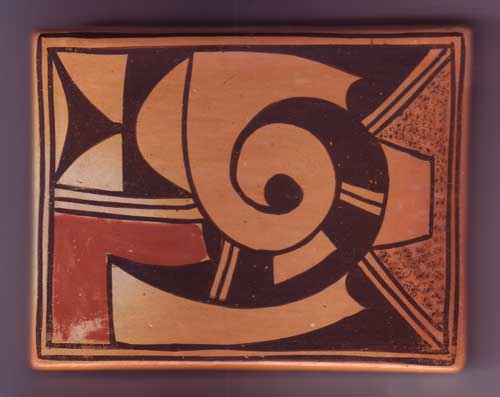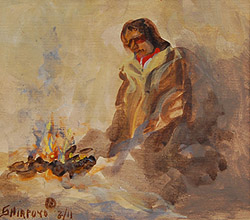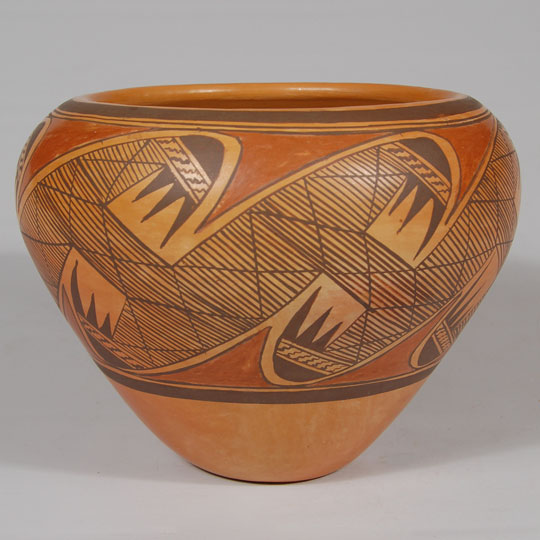Nineteenth Century Coin Silver Pictorial Navajo Spoon - C3393B
Navajo-made silver spoons with an Indian head profile at the end of the handle first appeared in Indian trader J. L. Hubbell's 1902 pamphlet. Hubbell assured his clients that these were made by Navajo silversmiths and were made from coin silver.
This spoon features an Indian head with feather bonnet in profile at the end of the handle and two arrows stamped in the bowl. Spoons were priced by weight of silver and not by their aesthetics. Spoons such as these were highly sought by tourists traveling on the trains to the southwest. They were attractive items, easily transported and easily displayed when back at home.
This spoon comes with a metal display stand fabricated specifically for this item.
Condition: there is a small crack on one edge of the bowl and the handle may have been repaired near the area of the bowl of this spoon.
Provenance: Coulter Brooks Gallery, Santa Fe
private collection of a Virginia family
Recommended Reading; Navajo Spoons: Indian Artistry and the Souvenir Trade, 1880s - 1940s by Cindra Kline
Subject: Nineteenth Century Coin Silver Pictorial Navajo Spoon
Unknown Maker
Category: Silverware
Origin: Diné - Navajo Nation
Medium: coin silver
Size: 4-5/8" long
Item # C3393B
Subject: Nineteenth Century Silver Navajo Spoon
The earliest dated silver spoon known to have been made by a Navajo was in 1885 and that was documented by Charles Lummis in his voluminous notes on file in the Southwest Museum. Spoons were a favored object of tourists travelling on the AT&SF Railroad that reached Santa Fe (actually, Lamy) New Mexico in 1879.
Potters, at that time, were making large pottery vessels because that was what they were used to making for their own use and expected the train tourists to need the same size for use at home. It was not readily understood that the tourists were seeking souvenirs, not functional items. That is where the highly decorated silver spoons developed. They were perfect items for tourists to drop in a carry-on purse or bag and take back home as a reminder of where they had ventured on vacation. They were the perfect souvenir.
This spoon features a twisted handle, with a flat section at the end of the handle and a stamped bowl at the other end. According to Cindra Kline inNavajo Spoons "Twisted handles were so popular in commercial spoon designs of the 1880s and 1890s that they were one of the features of the Robbins Company's 1904 commercial 'Navajo Spoons" [catalog] and were offered in Indian trader catalogs as late as 1906. Trader J. B. Moore promoted twisted handles as providing 'extra strength.' In addition, the end result was quite pretty."
Condition: original condition
Provenance: ex Kim Lowndes collection
Alan Kessler Gallery, Santa Fe
private collection of a Virginia family
Recommended Reading; Navajo Spoons: Indian Artistry and the Souvenir Trade, 1880s - 1940s by Cindra Kline
Subject: Nineteenth Century Silver Navajo Spoon
Unknown Maker
Category: Silverware
Origin: Diné - Navajo Nation
Medium: silver
Size: 3-7/8" long
Item # C3393A
Subject: Cochiti Pueblo Male and Female Pottery Figurines
This male and female pottery figurine couple was obviously made as a pair and has been together since probably the mid-1970s when they were likely made. Neither of the figurines is signed with the name of the maker but they were shown to Cochiti Pueblo potter Virgil Ortiz who said he believes they were made by Aurelia Suina.
Each of the figurines is dressed in traditional pueblo clothing. The female is wearing the traditional pueblo dress that is over one shoulder and under the other. It is cinched at the waist with a woven sash. She is wearing traditional brown moccasins, a necklace and bracelets on both arms. He is wearing a button-up shirt, also cinched at the waist with a woven belt. He has on traditional moccasins, a red headband and jewelry on both wrists and a nugget necklace with jaclas.
Condition: It is our speculation that these date to the 1970s and both figurines are in excellent structural condition with no evidence of repair of any kind. There are a few scratches here and there but nothing of great significance.
Provenance: from a client in Scottsdale, AZ
Recommended Reading: Clay People: Pueblo Indian Figurative Traditions by Jonathan Batkin
Subject: Cochiti Pueblo Male and Female Pottery Figurines
Artist / Potter: Aurelia Suina (1911 -?)
Category: Figurines
Origin: Cochiti Pueblo
Medium: clay, pigment
Size: 9-1/2" tall
Item # C3392
Subject: Late Historic Laguna Pueblo Polychrome Olla
We have been told that there is no word for "art" in the native languages of New Mexico and that what we perceive as art is part of the daily life and experience in a native household. Everything in their world has a connection to their religion and to their daily lives without there being a separation between the two. Beautification is accomplished in appreciation to Mother Earth for yielding up the clay and paint sources for the potter to use in making a vessel. Native potters, in their daily lives, produce objects of beauty that we, as collectors, consider to be art. We are fortunate to live in a state where there are so many talented potters whom we call artists.
This jar, which we believe was made at Laguna Pueblo at or just before 1940, is a marvelous example of a jar in which a potter expressed her own interest. The boldness of the design with the NASCAR-type flags certainly is unusual for a pueblo design but obviously meant something to the potter. The other designs that look somewhat like boomerangs also are quite unique. Perhaps they represent a combination of corn and rain clouds, but that is only speculation.
The jar is not too large but is very interesting in presentation. The boldness of the design overcomes the smaller jar size, a feat of which the potter was probably well aware. This is a jar that requires and demands attention. One cannot pass it by without stopping for a look.
Condition: structurally in excellent condition but does have some abrasion to the design but it is not significant.
Provenance: from the estate of Reggie Sawyer, the Hanging Tree Gallery, Albuquerque
Recommended Reading: Acoma and Laguna Pottery by Rick Dillingham
Subject: Late Historic Laguna Pueblo Polychrome Olla
Potter Unknown
Category: Historic
Origin: Laguna Pueblo
Medium: clay, pigment
Size: 6-7/8" tall x 10-1/2" diameter
Item # C3385D
Subject: Diné (Navajo) Painting of a Buffalo Hunt
Quincy Tahoma displayed a wide variety of styles in his paintings. He had a "quiet" period, a "peaceful" period and a "violent period." His quiet and peaceful periods were early and late in his career, with his violent period predominating for most of his art life.
Tahoma painted the proud Diné in everyday life on the reservation where he had grown up to the time of leaving for the Santa Fe Indian School at about age 12 or 13. When World War II broke out, he attempted to join the military service to serve with his many Native American friends who had joined, but a childhood accident which left his left arm deformed prevented his acceptance. He spent the war years in Santa Fe.
Painting buffalo hunts was a favorite Tahoma theme or perhaps it was a favorite of his clients because he made several such scenes although each was different. In this one, the bison is attacking the horse in an attempt to dismount the rider. It does not appear that the Indian has scored a hit on the bison with an arrow. There are several dozen bison in the far distance. The rider has singled out one from the herd.
Tahoma has provided a beautiful dramatic cloud in center background. It is obliterating the sun from view and the cloud appears so powerful and, yet, beautiful. The artist's choice of colors for the cloud is an indication of true artistic talent.
Condition: appears to be in original condition
Provenance: from a lady in Santa Fe
Recommended Reading: Quincy Tahoma the Life and Legacy of a Navajo Artist by Charnell Havens and Vera Marie Badertscher
Subject: Diné (Navajo) Painting of a Buffalo Hunt
Artist: Quincy Tahoma 1917-1956 Water Edge
Category: Paintings
Origin: Diné - Navajo Nation
Medium: gouache
Size: 12-1/2" x 20-3/4" image; 20-1/2" x 28-5/8" framed
Item # C3258
Subject: Hopi Migration Pattern Jar by Fannie
When Adobe Gallery had its Santa Fe gallery grand opening in May 2001, the opening exhibit was the private collection of Hopi pottery by the Nampeyo family that had been accumulated by Barbara Kramer during her years of research in preparation for writing the book Nampeyo and Her Pottery, published in 1996. Her collection had grown to 33 pottery pieces by various members of the Nampeyo family. The entire collection was exhibited during that exhibit.
It is now our pleasure to be able to re-post this one jar from that collection. It is a large jar made by Fannie Nampeyo in the mid-1960s and it is designed with the Hopi migration pattern, a pattern incorporating many parallel straight lines that must have been a nightmare for the potter to paint.
Fannie Nampeyo was the youngest daughter of Nampeyo of Hano and, as a result, is the daughter most recognized by collectors from the 20th century. Annie had passed away in 1968 and Nellie in 1978. Fannie lived until 1987. Of course, she was not making jars as large as this one during that last decade of her life but she was an active potter and she was very welcoming to visitors to her home, so many collectors knew her personally. I visited her frequently during that decade and am glad to have known her. She was the first one to demonstrate putting Vaseline on her fired pottery and then polishing it with old nylon hose. That is the reason that the paint on her pottery does not smear or rub off easily.
This jar is an excellent example of her mid-20th century style when she was able to make larger vessels and was very competent in designing and painting them. It is now a half-century old and still as beautiful as the day it was fired.
Condition: very good condition
Provenance: Purchased from a private collection by Dewey-Kofron Gallery, Santa Fe, which in turn sold it to Jim and Barbara Kramer in 1977. Exhibited in "Nampeyo of Hano and Her Daughters," at Adobe Gallery, Santa Fe, May 11 through 31, 2001.
Recommended Reading: Nampeyo and Her Pottery by Barbara Kramer
Subject: Hopi Migration Pattern Jar by Fannie
Artist / Potter: Fannie Polacca Nampeyo 1900-1987
Category: Contemporary
Origin: Hopi Pueblo
Medium: Native Clay, Slip & Vegetal Paint
Size: 7" high x 11" diameter
Item # C3388
Subject: Oil Painting "Dancing Cloud" Study by Logan Hagege
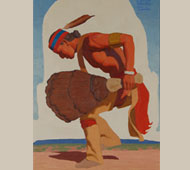 Logan Maxwell Hagege is a talented artist who excels in depicting the figure and landscapes. Serious study in art started for Logan when early interest in animation sent him to a local art school, Associates in Art. His interest quickly moved from animation to fine art while attending life drawing classes, and later the Academy's Advanced Master's Program, which was modeled after the old-time French Art Schools where students spent more than six hours per day studying from live models.
Logan Maxwell Hagege is a talented artist who excels in depicting the figure and landscapes. Serious study in art started for Logan when early interest in animation sent him to a local art school, Associates in Art. His interest quickly moved from animation to fine art while attending life drawing classes, and later the Academy's Advanced Master's Program, which was modeled after the old-time French Art Schools where students spent more than six hours per day studying from live models.
This artist has drawn inspiration for his subjects from his native Southern California as well as by traveling extensively to view various landscapes in the American Southwest and the Northeast Coast of the U.S.
Logan finds encouragement and guidance in masters of the past such as Gustav Klimt, N.C. Wyeth, T.W. Dewing and Maynard Dixon. One idea that drives Logan's work is that evolution in art is never ending. He is constantly challenging himself with new ideas and new ways of looking at the same subject.
In this small oil painting, Logan was laying plans for an anticipated larger painting. This one, entitled "Dancing Cloud" was a study effort. It is oil on linen, completed in 2010, signed in upper right and framed in a gold wood frame.
Condition: original condition
Provenance: from a private Santa Fe collector
Reference: Biographical information obtained from the artist's website.
Subject: Oil Painting "Dancing Cloud" Study by Logan Hagege
Artist: Logan Maxwell Hagege
Category: Paintings
Origin: European-American Artists
Medium: Oil on linen
Size: 12" x 9" image; 15-3/4" x 12-5/8" framed
Item # 25475
Subject: Tesuque Pueblo Polychrome Rain God Figurine
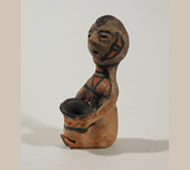 Tesuque Rain God figurines have enchanted collectors for over a hundred years now. Museum curators despised them in the 1880s and 1890s as abominations and a disgrace to the pueblo potters who were reduced to making such. Collectors, however, loved them apparently. Sales of them were a bonanza to Santa Fe merchants, such as Gold and Candelario. In the late-1890s, Jake Gold partnered with J. S. Candelario to open a curio shop on East San Francisco Street in Santa Fe.
Tesuque Rain God figurines have enchanted collectors for over a hundred years now. Museum curators despised them in the 1880s and 1890s as abominations and a disgrace to the pueblo potters who were reduced to making such. Collectors, however, loved them apparently. Sales of them were a bonanza to Santa Fe merchants, such as Gold and Candelario. In the late-1890s, Jake Gold partnered with J. S. Candelario to open a curio shop on East San Francisco Street in Santa Fe.
Jonathan Batkin, in The Native American Curio Trade in New Mexico stated that the only way for Gold to have sufficient merchandise for his new curio store was for him to develop some type of artifact and have the Pueblo Indians provide it in quantity. The most famous item of this category that Gold had a hand in was the development of the Tesuque rain god figurine, an item for which he was paying 5 cents each.
Gold both wholesaled and retailed rain god figurines. On a typical year, he retailed over 100 of them from the store and shipped those 100 to a barrel for wholesale customers for $6.50 per barrel. By 1907, he was shipping over 1000 rain gods annually. The sales continued for years, although at a lesser quantity during the depression years. Records indicate that Candelario shipped barrels of them to merchants in Colorado and New Mexico.
Thousands must have been made over the years by Tesuque potters, but only hundreds have survived. Curio items of any sort eventually get broken or thrown away but fortunately some collectors treasure them enough to keep them safe.
This figurine is typical of the style made between 1900 and 1925. The figurine was covered in cream slip over which the elaborate design was painted in black and red vegetal and mineral paints. The figurine has sculpted hair painted black and holds a decorated jar on his lap. The painted designs on the cheeks and painted eyebrows and eyes are typical of the early 1900s figurines. This is one of the more elaborately painted rain gods which makes one suspect it is one of the earlier ones before demand increased so significantly that potters began producing faster and decorating less.
Condition: The toes on the right foot are broken off; otherwise it is in original condition.
Provenance: from a gentleman in Taos, NM whose grandfather owned a curio store near the plaza.
Reference and Recommended Reading: The Native American Curio Trade in New Mexico by Jonathan Batkin
Subject: Tesuque Pueblo Polychrome Rain God Figurine
Potter Unknown
Category: Figurines
Origin: Tesuque Pueblo
Medium: clay, paint
Size: 7" tall
Item # 25621
Subject: Nineteenth Century Tesuque Rain God
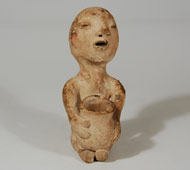 The origin of Tesuque Rain Gods is still somewhat in question. They may be an indigenous development out of a more general Tewa tradition. Before the emergence of the figurine as we know it today, there existed figurines closely related to Kokopelli, the humpbacked, phallic flute player. These early figurines displayed sexual characteristics of male and female genders. A strong similarity exists between these ancestral Rain God figurines and the late 19th century ones. The sexual characteristics disappeared rapidly once the figurines became commercial products.
The origin of Tesuque Rain Gods is still somewhat in question. They may be an indigenous development out of a more general Tewa tradition. Before the emergence of the figurine as we know it today, there existed figurines closely related to Kokopelli, the humpbacked, phallic flute player. These early figurines displayed sexual characteristics of male and female genders. A strong similarity exists between these ancestral Rain God figurines and the late 19th century ones. The sexual characteristics disappeared rapidly once the figurines became commercial products.
Their entry into the commercial realm was due to a Santa Fe merchant named Jake Gold who offered Tesuque potters ten cents for each figurine. The potters removed the sexual characteristics from the dolls (probably at the request of Gold) and placed a pot in the lap or on the head. Thus we have the Rain God, as we know it today.
This fine example of a Tesuque Rain God, which probably dates to circa 1890s, originally had paint on his cheeks but most of that is worn away. It appears that the figurine might have had a short beard on his chin but it is not clearly evident that this is so.
Condition: the right foot is partially broken off but not very evident because it is under the jar.
Provenance: from a young man in Albuquerque who inherited it from his grandfather who grew up on Tesuque Pueblo.
Recommended Reading: The Native American Curio Trade in New Mexico by Jonathan Batkin
Subject: Nineteenth Century Tesuque Rain God
Potter Unknown
Category: Figurines
Origin: Tesuque Pueblo
Medium: clay, paint
Size: 5-1/2" tall
Item # C3387
Subject: Historic Acoma Pueblo Polychrome Olla, circa 1940s
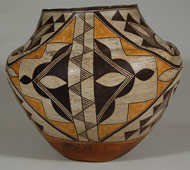 This Acoma olla dates to circa 1940s, and is a superb example of a potter's art. As all traditional pottery of that time period, this olla was formed of native clay with ground pottery shard temper, rag-wiped white slip, red neck interior, and red-slipped underbody with concave base, typical of Acoma pottery.
This Acoma olla dates to circa 1940s, and is a superb example of a potter's art. As all traditional pottery of that time period, this olla was formed of native clay with ground pottery shard temper, rag-wiped white slip, red neck interior, and red-slipped underbody with concave base, typical of Acoma pottery.
The high point of maximum diameter, design elements, execution and a shorter neck are indicative of vessels of this time period. The artist chose not to divide the design field into distinct areas separated by division lines; rather, she chose to use the full field to express a single artistic concept.
The rim top and dual framing lines are worked in black paint from a mineral source, which is really dark brown, and are without ceremonial breaks. The fine line and geometric/curvilinear elements are mineral black on rag-wiped white slip, with additional embellishments in typical orange.
There are two main elements of design incorporating the full extent of the jar. One element, on opposing sides of the jar, is a large diamond from rim to lower framing line and from mid-body extending to the adjacent design elements, which, also on opposing sides, are comprised of absolutely exquisite all-black triangles, fine lines, and curvilinear elements. The diamond elements are split down their centers with a band of fine-line triangles alternating left and right. Within the triangles to the left and right of this split are strong black elements and orange triangles.
The all black-on-white sections of the design are graceful in their emphasis on the four long curving lines of solid black with appended black triangles and fine line cloud-like elements. Overall, the jar is beautifully decorated in any position it is viewed. The painting is evidence of an outstanding potter.
Condition: The integrity of the vessel is excellent. There is a slope to the upper rim of the jar but that is the manner in which the potter constructed the vessel.
Provenance: from the estate of Reggie Sawyer, the Hanging Tree Gallery, Albuquerque
Recommended Reading: The Pottery of Acoma Pueblo by Lanmon and Harlow
Subject: Historic Acoma Pueblo Polychrome Olla, circa 1940s
Category: Historic
Origin: Acoma Pueblo
Medium: clay, pigment
Size: 9-3/4" tall x 11" diameter
Item # C3385B
Subject: Bronze Sculpture of Kocha Mosair - White Buffalo
Many of the Hopi dances hold social as well as symbolic purposes and act to unite the men and women of the tribe. In the "White Buffalo" dance, a man dresses as and acts the part of the animal; head tucked downward, he paws the earth with his feet and creates movements that recall the animal vividly. The man's partner will be dressed in a very feminine outfit somewhat representing the Palhikmana or Butterfly Maiden Katsina. Danced as a prayer for the increase of buffalo, and is borrowed from another tribe's heritage, this ceremony is a prayer for health and prosperity also.
Elements of ceremonial dress include a kilt, from the back of which emerges a sash that represents the buffalo's tail. The dancer's head covering incorporates horns and frames his face.
Lowell Talashoma, Sr., was a Hopi artist whose bronzes were cast from carvings done by him in cottonwood root. His images were inspired by Hopi belief and "liberated" from the raw material through the artist's vision of what was within. Although he could work faster in preparation for bronzing by using wax or clay, Lowell preferred to interact with the wood, a material he respected for its inherent life and character. The castings made from his carvings via the lost wax method retain that spirit. Even the grain of the original wood can be discerned in the bronze.
This bronze casting of the White Buffalo was issued in an edition of 35 in 1983. This is number 1 of the edition.
Condition: bronze is in original condition.
Provenance: from the estate of a California family
Recommended Reading: Kachinas: a Hopi Artist's Documentary by Barton Wright
Subject: Bronze Sculpture of Kocha Mosair - White Buffalo
Artist / Carver: Lowell Talashoma, Sr. (1950-2003)
Category: Bronze
Origin: Hopi Pueblo
Medium: bronze casting, wood pedestal
Size: 10-3/4" tall including pedestal
Item # C3365E
Subject: Hopi Seated Mudhead Painting a Tihu
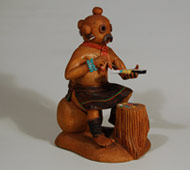 The Koyemsi are best known as Mudheads because of the color of their head coverings. The Koyemsi were imported from Zuni Pueblo in the late 1800s by the Hopi to replace their equivalent one called Tachuki, which no longer exists at Hopi. Only the Zuni-style Koyemsi exists at Hopi now. The name Mudhead is an English name given by traders and others.
The Koyemsi are best known as Mudheads because of the color of their head coverings. The Koyemsi were imported from Zuni Pueblo in the late 1800s by the Hopi to replace their equivalent one called Tachuki, which no longer exists at Hopi. Only the Zuni-style Koyemsi exists at Hopi now. The name Mudhead is an English name given by traders and others.
Legend has it that Koyemsi were born of an incestuous union between brother and sister and the knots on their head are deformity as a result of the relationship.
According to Barton Wright "The Koyemsi are not considered to be Kachinas and they live in a separate location...near the kachinas home...but are not a part of them."
The Koyemsi are not clowns in the manner of the Koshari. When the Koyemsi "clown around" it is in the guise of playing games with children or even adults, not being buffoons.
In this presentation of a Katsina doll, Ronald Honyouti has correctly dressed the Mudhead in the black woman's manta, a fragment of which is worn as a kilt. The Mudhead is painting a flat katsina doll (tihu) of Hahai-i-Wuhti, which will be a present to a Hopi child during the Powamu Ceremony in February. Hahai-i-Wuhti is the first Katsina doll presented to a newborn.
Amazingly, the entire doll appears to have been carved from a single cottonwood root. The paint brush is the only added feature. When one attempts a carving as complicated as this, there is no room for a mistake. It must be planned carefully and accurately, which is what Honyouti certainly did. Ronald Honyouti and his brothers, Loren and Brian, are considered among the finest katsina doll carvers on the reservation and one can certainly see the reason when viewing this magnificent carving.
Condition: original condition
Provenance: from the estate of a family from Kentucky
Recommended Reading: Clowns of the Hopi: Tradition Keepers and Delight Makers by Barton Wright
Subject: Hopi Seated Mudhead Painting a Tihu
Artist / Carver: Ronald Honyouti (b.1955)
Category: Traditional
Origin: Hopi Pueblo
Medium: cottonwood root, stain, paint
Size: 9" tall; 6-3/8" x 5-3/8" pedestal
Item # C3379A
Subject: Original Painting of Pueblo Male Chanters
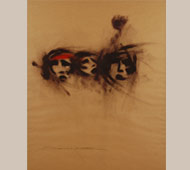 Unquestionably the outstanding Tesuque Pueblo painter and one of the most outstanding of all the pueblo artists was Patrick Swazo Hinds. Adopted at the age of 9 by a California family, Swazo grew up off the reservation but returned every summer to Tesuque. It is this exposure to a different way of life that is probably responsible for his style of art and that, in turn, is responsible for his wide appeal and his great success as an artist.
Unquestionably the outstanding Tesuque Pueblo painter and one of the most outstanding of all the pueblo artists was Patrick Swazo Hinds. Adopted at the age of 9 by a California family, Swazo grew up off the reservation but returned every summer to Tesuque. It is this exposure to a different way of life that is probably responsible for his style of art and that, in turn, is responsible for his wide appeal and his great success as an artist.
Swazo exhibited widely in the West, with many general or one-man shows in Berkeley and San Francisco, and in Arizona, New Mexico and Oklahoma. Some of his one-man shows were at the Heard Museum, Phoenix, Pacific School of Religion, Berkeley, and the Beaux Arts Gallery, Oakland-all in the 1960s-and another show, a very superior one, at the Heard in 1970. His awards at these and other shows are much too many to mention. He frequently won First and Purchase awards.
Swazo easily combined a Native American inheritance by birth with an Anglo education to produce a painting style he described as "Indian theme to nonobjective abstract." He is still recognized as a major artist of the 20th century.
In this painting-believed to be oil on paper-Swazo illustrates three pueblo men chanting, most likely during a pueblo plaza dance. The men are illustrated completely in brown color, with only one man wearing a solid red bandana around his head. One can almost visualize Swazo with a brush loosely and casually applying strokes to the paper. It is this loose style, with no fine detail, that makes his art so appealing.
The painting is signed Swazo in lower left in very broad strokes. It has recently been examined out of the frame and put back in using spacers between paper and glass and using acid-free materials for backing the painting. UV filtering Conservation Glass replaced the original glass. The red wood liner and the dark brown wood frame perfectly compliment the painting.
Condition: original condition
Provenance: from the personal collection of Margaret Gutierrez, potter of Santa Clara Pueblo
Recommended Reading: Southwest Indian Painting: a changing art by Clara Lee Tanner
Subject: Original Painting of Pueblo Male Chanters
Artist: Patrick Swazo Hinds 1929-1974
Category: Paintings
Origin: Tesuque Pueblo
Medium: oil on paper
Size: 17-1/4" x 14-1/4" image; 20" x 17" framed
Item # C3372D
Subject: Original Painting "Pueblo Women Decorating Pottery"
Gilbert Atencio's family included four siblings, one of whom was Helen Gutierrez, a well-known potter from Santa Clara Pueblo. His parents were Isabel Montoya (1899-1996) and Benjamin Atencio (? -1963). His grandmother and Maria Martinez's mother were sisters. His niece is Geraldine Gutierrez who is a painter and potter living at Santa Clara Pueblo.
Atencio attended the Santa Fe Indian School. By the time he was twenty, he had exhibited at the Santa Fe Museum, the Gallup Inter-tribal Indian Ceremonial, at Albuquerque venues, and at the Philbrook Art Center in Oklahoma. He had been awarded six first prizes, six second prizes and five third prizes by the age of 19.
He will certainly be recognized as one of the finest pueblo painters of the second half of the 20th century, not only from San Ildefonso Pueblo, but among all pueblo painters. His attention to detail was unequalled. As a professional medical illustrator at Los Alamos National Labs (LANL), Atencio carried forward his precise drawing and painting skills over to his fine art paintings. I have been told that he practiced the same diligence relating to ceremonial functions at the pueblo. He did not tolerate less than perfection.
"Atencio's strong sense of family and tribal responsibility has resulted in his seldom venturing from his native pueblo. He experimented with adaptations of his flat style paintings. The artist believes in the traditional Indian ways and his favorite subjects were ceremonies, ceremonial figures, and scenes from Pueblo life. Much of his inspiration came from stories his aunts told him about their lives." Snodgrass, 1968
"San Ildefonso Pueblo's fame as an art center, save for the work of a few men, has diminished in the painting field. One of the main standard bearers is Gilbert Atencio, who has thus far seldom departed from developments of time-honored themes and forms. His crisply drawn and clearly colored renderings of ceremonial and home life have, since around 1947, been favorites in many shows." Dorothy Dunn, 1968
Gilbert Atencio was known for his paintings but little known as a potter. Later in life, he did make pueblo pottery but that was for his own pleasure. Paintings remained his second profession following his retirement from Los Alamos National Labs (LANL). His ability to paint medical illustrations, paint pueblo life scenes, and make pottery illustrates his extraordinary artistic talent.
In this painting, Atencio illustrates four pueblo women in various stages of decorating their pottery. As a potter, Atencio knew that one cannot touch a pot with one's bare hands after construction because hand- and fingerprints will show up on the surface, but only after firing. He illustrated this concept by showing the women holding their pottery with buckskin. It was his knowledge as a potter that led him to do this. I do not recall seeing any other pueblo painter do so. This is typical of his attention to detail. The four women are presented in their finest clothing. His detail in their attire is remarkable as was his treatment of the designs on the pottery.
Condition: original condition
Provenance: from the personal collection of Margaret Gutierrez, potter of Santa Clara Pueblo
Recommended Reading: American Indian Painting of the Southwest and Plains Areas by Dorothy Dunn
Subject: Original Painting "Pueblo Women Decorating Pottery"
Artist: Gilbert Atencio (1930-1995) Wah Peen
Category: Paintings
Origin: San Ildefonso Pueblo
Medium: casein on paper
Size: 16-1/2" x 22" image; 21-3/4" x 27-1/2" framed
Item # C3372B
Subject: Kewa (Santo Domingo) Depression-era Necklace
This necklace was made from several "found materials." The beads were made from bone, the black backing probably from automotive battery casing, the red from toothbrush handles or something similar, and the turquoise is genuine. These necklaces were usually in the squash blossom style, with pendants protruding from the sides and a bird pendant at the bottom, as is this one.
Most necklaces of this style have a pendant bird in the shape of the mythical thunderbird, a squared-off bird facing full forward. This necklace features a more realistic Kewa-style bird as seen on that pueblo's pottery-a much rarer style of pendant.
During the 1930s when the Depression-era was in full swing, New Mexico Pueblo Indians were severely affected. At Santo Domingo Pueblo (now Kewa Pueblo), the Indians became very resourceful and began producing jewelry from whatever materials they could find. One particular folk art creation they produced has become a very collectible item: the Depression-era necklace. Production continued at a lesser rate into the mid-20th century.
Condition: very good condition
Provenance: from the personal collection of Margaret Gutierrez of Santa Clara Pueblo
Recommended Reading (Article): Santo Domingo Pueblo Jewelry by Sally and J. Roderick Moore in The Magazine Antiques, Brant Publications, Inc. July 2009, vol. CLXXVI, no. 1. pp. 56-61
Subject: Kewa (Santo Domingo) Depression-era Necklace
Unknown Maker
Category: Necklaces
Origin: Kewa Pueblo (Santo Domingo)
Medium: found materials, turquoise
Size: 27" long; 2" x 2-1/2" bird
Item # C3371D
Subject: Hopi Pueblo Polychrome Pottery Tile by Garnet Pavatea
Garnet Pavatea was one of the best known of the non-Nampeyo family potters at Hopi First Mesa. She was an extraordinary artisan. Garnet had a long and productive career of pottery making and was a favorite of collectors of Hopi pottery. Her father was a Hopi and her mother a Tewa. She lived at the Tewa Village on First Mesa on the Hopi Reservation. She was an active potter from circa 1940 to circa 1981. She is best known and was fond of making plain red bowls and jars with triangular indentations around the rim as the sole decoration. Often, she made ladles to accompany her bowls. The Museum of Northern Arizona in Flagstaff amassed a major collection of her work.
In checking our history files of pottery, we discovered that we have not had a pottery tile by Garnet in the 10 years that we have maintained computerized files of pottery purchases. I do not know if we ever had one before, so it is exciting to have one now.
The tile is signed on verso Garnet Pavatea. It is in very good condition. There is some abrasion of the red paint at the edge of the tile, but it is minor.
Subject: Hopi Pueblo Polychrome Pottery Tile by Garnet Pavatea
Aritst: Garnet Pavatea (1915-1981) Flower Girl
Category: Contemporary
Origin: Hopi Pueblo
Medium: Native Clay
Size: 5" x 4"
Item # C3011J
Subject: Polished Red Incised Bear with Turquoise by Tony Da
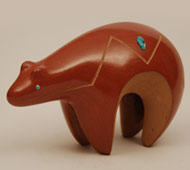 Tony Da, from San ildefonso Pueblo, was destined to become one of the finest artists of the 20th century. His grandparents, Maria and Julian Martinez, and his father, Popovi Da, were skilled artists. Tony was a painter from early in life, and was winning awards for his paintings. A change occurred when he moved in with his grandmother in 1966. She taught him the techniques of pottery making and he learned very well. Within three years, Maria said he had nothing else to learn from her.
Tony Da, from San ildefonso Pueblo, was destined to become one of the finest artists of the 20th century. His grandparents, Maria and Julian Martinez, and his father, Popovi Da, were skilled artists. Tony was a painter from early in life, and was winning awards for his paintings. A change occurred when he moved in with his grandmother in 1966. She taught him the techniques of pottery making and he learned very well. Within three years, Maria said he had nothing else to learn from her.
Once Tony started making pottery, his creativity took over. He followed all the traditional techniques Maria had taught him, but he blossomed in departing from traditional shapes and designs. He was fond of the Mimbres culture and used their designs on much of his work.
Tony's first pottery pieces were bears. Maria commented that he was very good and she could not do anything to make him better, except that he needed to learn to make ollas, which, of course, he did. In 1982, Tony suffered massive head injuries in a motorcycle accident, which left him unable to continue his pottery career.
From published examples of his bear figurines, it appears that he made them starting in 1966 and continued making them into the late 1970s, perhaps even until his 1982 accident.
The upper body is stone-polished red slip and the underbody is natural unpolished, unslipped tan clay. Into the red slip, Tony carved a heart line from the bear's mouth to his rear. He inserted two pieces of turquoise on the bear's body and two pieces for eyes. He signed his traditional signature DA on one leg. The condition is excellent.
Large bears such as this are extremely rare. I am not aware of another one on the market at this time.
Recommended Reading: The Life and Art of Tony Da by Charles King and Richard Spivey
Subject: Polished Red Incised Bear with Turquoise by Tony Da
Aritst: Tony Da (1940-2008) - Anthony Edward Da
Category: Contemporary
Origin: San Ildefonso Pueblo
Medium: Native Clay and Slip, Turquoise
Size: 6-1/2" long x 4" tall x 3-1/4" wide
Item # C3360F
Subject: Original Acrylic Painting "Tiwa Deer Hunter"
This late evening winter scene captures the coldness of the air and ground while a pueblo hunter huddles near a small, smoky fire of piñon or cedar, contemplating his strategy-possibly overnight. At the same time the painting reflects the warmth and coziness of being wrapped in a blanket. Even though it's miniature in size, this is a very powerful painting and is one of our favorites from this artist.
Subject: Original Acrylic Painting "Tiwa Deer Hunter"
Artist: Ed Jojola (Shirpoyo) Colors in the Sunrise
Category: Paintings
Origin: Isleta Pueblo
Medium: Acrylic on Board
Size: 2-7/8" x 3-1/4" image; 4-3/8" x 4-3/4" framed
Item # C3127B
Subject: San Felipe Pueblo Large Polychrome Olla
Joseph Latoma is a young man who lives at San Felipe Pueblo. His dad is from Zuni Pueblo-thus the reason for his Zuni name-but his mom is Margaret Chavez of San Felipe Pueblo-thus his matriarchal link to San Felipe Pueblo.
Because there is so little documented historic pottery from San Felipe, Latoma has had to create his designs from memories of the older generation of the pueblo. He is very interested in reintroducing traditional San Felipe pottery. The only older potter from there in the last 50 years was Candelaria Montana and she passed away about 20 years ago.
This very large olla was made in the traditional pueblo coil method and slipped with natural regional clay. The designs are a combination of geometric, avian, flora and celestial, all arranged in a most artistic and logical manner. The artist applied the designs in a most precise manner. To protect the design from fire clouds during the firing process, he completely covered the jar with another ceramic jar during the firing. The result is a stunning jar without flaws.
Condition: new condition
Provenance: from the artist
Subject: San Felipe Pueblo Large Polychrome Olla
Artist / Potter: Joseph Latoma
Category: Contemporary
Origin: San Felipe Pueblo
Medium: clay, pigments
Size: 13-3/4" tall x 16" diameter
Item # 25553
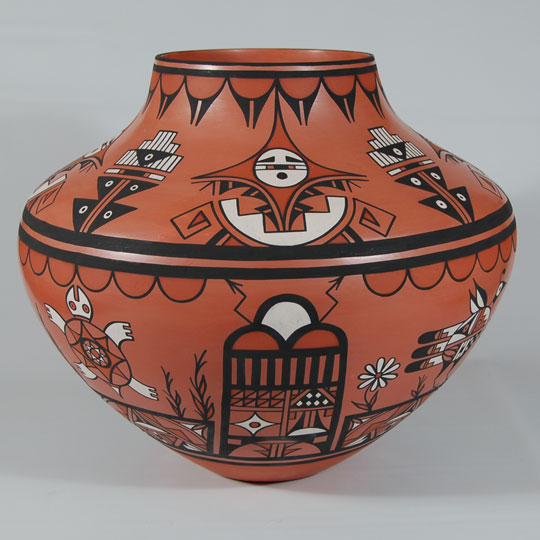
Subject: Hopi Polychrome Jar by Priscilla Nampeyo
This is an extraordinary piece of pottery by Priscilla Nampeyo. It is beautifully formed, using native clay and the coiling technique. A strong decoration consists solely of the traditional Sikyatki-inspired migration pattern starting at the rim and flowing downward to near the base. It has been stated that this pattern reflects the migration of the Hopi through four worlds to this current one.
The jar is signed Priscilla Namingha, a signature, I believe, she used into the 1980s, after which she added Nampeyo to her name. There is a wonderful interview of Priscilla Nampeyo by Greg Schaaf in his book Hopi-Tewa Pottery 500 Artist Biographies.
Condition: The jar is in original excellent condition
Provenance: ex. coll. Frances Sonnenberg, Santa Fe resident
Subject: Hopi Polychrome Jar by Priscilla Nampeyo
Artist / Potter: Priscilla Namingha Nampeyo (1924-2008)
Category: Contemporary
Origin: Hopi Pueblo
Medium: Native materials
Size: 4-3/8" tall x 5-3/4" diameter
Item # C3148A


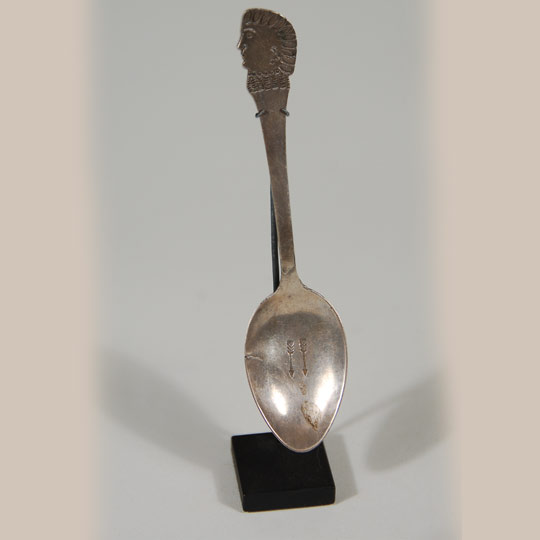
![Nineteenth Century Silver Navajo Spoon The earliest dated silver spoon known to have been made by a Navajo was in 1885 and that was documented by Charles Lummis in his voluminous notes on file in the Southwest Museum. Spoons were a favored object of tourists travelling on the AT&SF Railroad that reached Santa Fe (actually, Lamy) New Mexico in 1879. Potters, at that time, were making large pottery vessels because that was what they were used to making for their own use and expected the train tourists to need the same size for use at home. It was not readily understood that the tourists were seeking souvenirs, not functional items. That is where the highly decorated silver spoons developed. They were perfect items for tourists to drop in a carry-on purse or bag and take back home as a reminder of where they had ventured on vacation. They were the perfect souvenir. This spoon features a twisted handle, with a flat section at the end of the handle and a stamped bowl at the other end. According to Cindra Kline in Navajo Spoons "Twisted handles were so popular in commercial spoon designs of the 1880s and 1890s that they were one of the features of the Robbins Company's 1904 commercial 'Navajo Spoons" [catalog] and were offered in Indian trader catalogs as late as 1906. Trader J. B. Moore promoted twisted handles as providing 'extra strength.' In addition, the end result was quite pretty." Condition: original condition Provenance: ex Kim Lowndes collection Alan Kessler Gallery, Santa Fe private collection of a Virginia family Recommended Reading; Navajo Spoons: Indian Artistry and the Souvenir Trade, 1880s - 1940s by Cindra Kline](https://www.adobegallery.com/uploads/C3393A-spoon.jpg)
